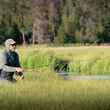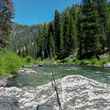A chilly autumn breeze filters through white oak leaves. They’re on the cusp of turning from the tired green of late summer to autumn russet. Within the gentle rustles is another sound. This one is not so easily identified.
“Didja hear that?” whispers Henry Adams (not his real name). And, indeed, I did. A single hardwood knock thumped from somewhere deep in the Ozark hollow below us. It could have been a pileated woodpecker, but the big crimson crested birds usually rap with a faster rhythm and more beats. Woodpeckers sound like a drum roll. This was a heavy and deliberate thud with sharp tones shaping the acoustics. It sounded solid. Most likely wood on wood or maybe even flesh on flesh, a massive hand clap or gorilla-like chest thump. Definitely not avian, or so says Adams.
“No, that was no woodpecker. Too much weight behind it.” But like the woodpecker’s rat-a-tat-tat, Adams says that this sound is also a form of communication. “You can hear them from over a mile away,” Adams says. “One knock is just like a ‘hello.’ Two knocks is ‘I hear you?’ And three knocks means ‘I’m on my way.’ If we hear three knocks things could get real interesting real fast.”
Adams answers the knock from the hollow by whacking a heavy club of dense green hickory against a red oak twice the diameter of himself. That’s a big tree because Adams is a bear of a man. He stands well over six and a half feet tall and weighs close to 300 pounds. When he unloads on the red oak a wallop rings through crisp mountain air like batting practice in the big leagues. The reply is not long in coming. Two knocks, sounding even more powerful than Adam’s, boom back up the hollow. The sound waves seem to vibrate our bones. Adams grins with affirmation. “Nah, that’s no woodpecker.”
Adams seems invigorated, as if the forest itself has provided validation for his life's work.
More Like This
Adams is a Bigfoot researcher specializing in the Southern Mountain sub-species of Bigfoot or Sasquatch or skunk ape or a hundred other names and nicknames associated with the mysterious creature. Adams’ research territory stretches from the Blue Ridge Mountains of Appalachia, west to the Ozark and Ouachita Mountains here in Arkansas. And it just so happens that the River Valley region — conveniently where I live — sits between two Bigfoot hotspots. One area is in the Ouachita Mountains near Perryville and the other is here, somewhere in northern Pope County, at an area Adams made me swear not to disclose. It’s an area I am familiar with through hiking, hunting, and fishing.
Large rocks, boulders even, are stacked in an unnatural manner just a few feet from the red oak Adams uses as a woodland percussion instrument. The cairns stand about seven-feet tall and some of the rocks must weigh nearly 500 pounds. The stack looks like a monument of some sort, but on this roadless, isolated ridge it’s hard to believe a man would do this. Also, it seems impossible without heavy equipment or at least block and tackle. And then you’d have to ask “why?”
Adams believes the cairns could be trail markers, memorials, or even some kind of altar. Does Adam’s think that Bigfoot could have religion?
“Who knows," says Adams, "but these are definitely not man-made.” He scratches his beard and studies the rocks. “Or maybe that depends on your definition of a man.”
According to Adams, Bigfoot is not an individual. Bigfoot are what Adams believes to be a population of bipedal primates native to North America. “I think they probably came across the Bering land bridge like the first humans in North America did,” Adams says. “They’re probably most closely related to orangutans, an Asian ape and descendent of Gigantopithecus (an extinct 10-foot tall ape) what with the red hair and all.”
Adams has some semi-solid science behind his speculations. He’s right about the Bering land bridge and humans crossing it. He's right about orangutans and even Gigantopithecus. But from there, the evidence gets flimsy. The problem is that no scientist has ever been able to examine a Bigfoot, dead or alive, in order to substantiate the speculations. Plaster casts, shaky video, fuzzy photos, and a lot of “eyewitness” accounts make up the body of evidence for the existence of the creature. But what science needs is a real flesh and blood body. Adams believes that will come along soon, though. “I think we’ll have a specimen within the next decade.”
And that’s what Adams is working toward. He believes a better understanding of the biology, physiology, and habits of Bigfoot will lead to a solid physical encounter of the type that can be documented by science. So this afternoon and evening we’re running ridges, looking and listening for signs of a beast that most rational people don’t believe exists. Adams is not deterred by overwhelming public opinion or science, and he notes that Bigfoot sign — visual and audible — is everywhere in the mountains of Arkansas.
“What people don’t think about is that Bigfoot is a primate; it’s an ape. And like all apes, they are extremely clever.” According to Adams, this in combination with a sparse population is why Bigfoot are rarely seen. “Arkansas has around 4,000 black bears, but how often do folks see a black bear? How many times do people come across a black bear carcass? The answers are rarely, unless the bears are baited, and never,” Adams says. “Now, think about a population of, say, 500 great apes, animals nearly as smart or maybe even smarter, in a different way, than we are. Yeah, good luck finding one.”
But, their one weakness, according to Adams, is that Bigfoot are not above the laws of physics and biology. “Their Achille’s heel, the one chink in their stealth, is that an animal of that size must leave sign — tracks, droppings, feeding sign— and, since they are social animals, they must have ways to communicate. This includes visual communication like twisted trees and cairns, as well as audible communication”
Bigfoot communication is what we are relying on tonight. Besides tree knocking, Adams says that Bigfoot communicate with chirps, whistles, growls, howls, and hoots. “They can mimic just about any sound in the forest,” Adams says. “And they use this mimicry to communicate right under our noses. For instance, they often hoot like a barred owl. The difference is a slight growl at the end of the call and a slightly different rhythm. But the differences aren’t noticeable to the untrained human ear.” Luckily, Adams says he can easily differentiate after hearing literally hundreds of Bigfoot calls.
We have, in fact, heard what I took to be a barred owl earlier in the afternoon. Adams was unsure about the call’s creator. The distance was too great for an accurate assessment. But the tree knocks were close, less than a quarter-mile, and they were distinctly different from any other sound of the forest.
Beside the rock towers, Adams points to another sign — a sapling, big around as my wrist, twisted like a wrung-out dishrag. Few animals in the Ozarks could do that kind of specific damage to a tree this size. “Maybe a bear or a large whitetail buck that got his antlers wrapped around it, but it’s really too high for a deer,” Adams says. The twist is at the eight-foot mark on the tree. “And I guess maybe an elk, but the whole thing about the antlers twisting up a tree strikes me as improbable. You really need some opposable thumbs to twist things. And there's only supposed to be two animals with opposable thumbs in North America. I don’t think humans or possums (opossums have opposable thumbs on their hind feet) have the strength to do this.”
Screams and hoots can be explained away as coyotes and owls. Tree knocking? Well, that’s a little tougher, but often the human ear hears what it wants to hear. Twisted saplings are strong evidence of a critter we haven’t identified yet, but elk and big deer are a possibility. These cairns, though, are tougher to explain. Hoaxers first come to mind, but you’ve got to ask “why?” And it seems especially unlikely given the remoteness of our location. Adams could be the instigator. But there is no sign of equipment use and, robust as he is, there is no way he could stack 200-500 pound stones in five separate piles and each one more than head high.
And, again, you must ask “why?” Adams doesn’t make any money in his research. He’s not marketing a book or a career of any kind. He’s simply a man looking for answers in the wilds of our eastern highlands.
“I don’t really know why I do it,” Adams says. “I’m broke most of the time and most everyone thinks I’m a crackpot. The wife left me some years back because of this obsession. I’m just one of those guys that’s got to find an answer. And so far, I haven’t found much, just enough to keep me digging.”
The shadows lengthen as Adams and I lean against the ancient red oak. Sundown is nearly here and darkness creeps up from the creek bottom. Still, we wait for hours and neither hear nor see anything not easily explained.
A pearly moon lights our ridge-top path back to the truck parked more than a mile away. Adams doesn’t use any electronics because he believes Bigfoot can sense them. Artificial lights are especially discouraged. We stop occasionally to check the compass by moonbeam and here in the wilderness, miles from any other known soul, I catch Adams' spirit.
The romantic in me wants it to be true. Maybe there is a chance, a possibility however slim. But then it’s gone, and I know in my logical mind that a giant North American ape simply does not exist.
The bright moon reflecting off the truck’s windshield tells us we’ve made it back, and as we take the last steps through crunchy leaves Adams pauses with one hand on the truck door. “Well, it didn’t go as well as I hoped it would,” he says. “But you did get to hear a couple of solid tree knocks.”
I nod and start to say thank you… but I’m interrupted by three thudding tree knocks echoing through the Ozark forest.
We decide to sit in the woods for just a little while longer.

































Comments